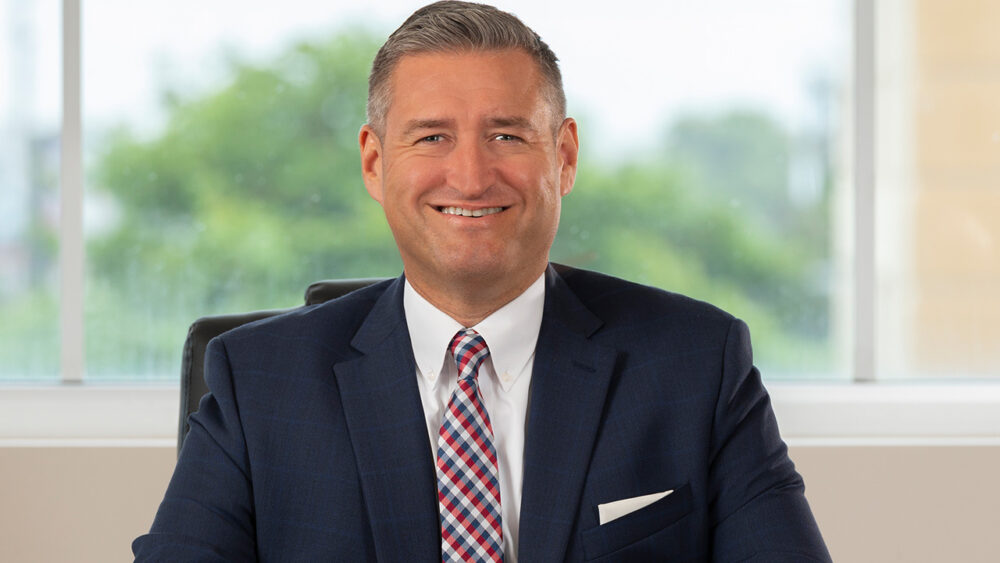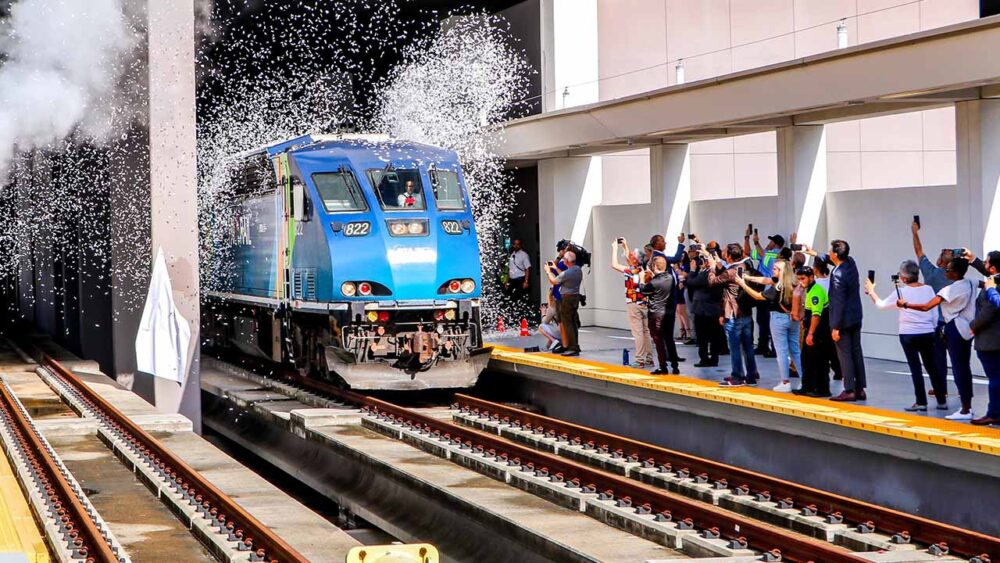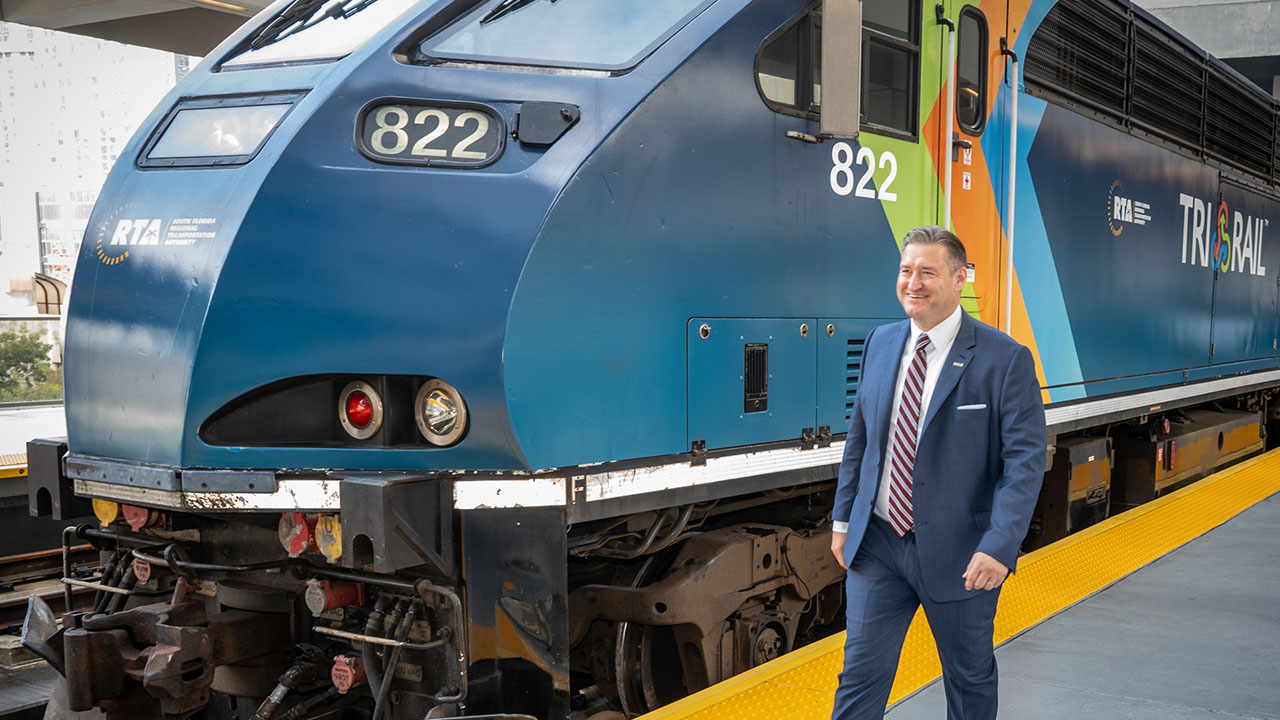Tri-Rail has opened a new way to get to downtown Miami with a service launch to the MiamiCentral station already used by Brightline. That’s great news for leisure riders and commuters who can easily hop aboard nearby stops for Metrorail and Metromover, a free service that runs to Brickell Avenue and around downtown.
Long term, Tri-Rail wants to play a key role in commuter service along the FEC Railway tracks and foster development at its stations.
SFBW spoke about the new service and longer-term opportunities with David Dech, executive director of the South Florida Regional Transportation Authority, parent of Tri-Rail.
Dech (pronounced like “deck”) commutes daily via Tri-Rail from Boca Raton to his office in Pompano Beach, which has a view of the station outside his window.
Dech is a fourth-generation railroader who started out as a brakeman and switchman. He later became a locomotive engineer and an executive with a Six Sigma Blackbelt certification.
Dech first heard about the Downtown Miami Link Service when he was assistant vice president[JM1] of passenger and commuter rail at CSX and visited SFRTA Executive Director Jack L. Stephens.
Stephens laid out plans showing the elevated station in Miami and a new connection in Hialeah between SFRTA’s tracks and the Florida East Coast Railway.
Both knew the Federal Railway Administration would require a host of safety measures including new safety equipment being adopted by railways nationwide.
“I left thinking I am so glad it’s him and not me,” Dech says.
Stephens was succeeded by Steven Abrams, an attorney and former elected official in Palm Beach County, who left by amid delays in opening service to Miami.
Before joining the SFRTA in August 2022, Dech had been serving as vice president of rail operations for Capital Metro in Austin, Texas, where he helped open a downtown station similar to Miami.
With his decades of railway experience, Dech seems at home with a desk facing real-time monitors showing any trains in the system—whether Tri-Rail, Brightline, Amtrak, CSX freight or FEC freight.

A complex project
Signs for Tri-Rail have been at MiamiCentral since it opened in 2018.
After Dech explained the complexities of the project, it starts to make sense why everything took so long.
The 9.05 miles of tracks from Hialeah to the FEC mainline never had passenger service. A lot of legal agreements were needed. The Federal Railroad Administration has stringent training for safety. FEC and Brightline changed plans from one type of safety system to another.
New safety equipment was installed in Tri-Rail’s Brookville Equipment Corp. locomotives. Boarding step modifications were needed for both the locomotives and the Hyundai Rotem coach cars that shuttle passengers from Tri-Rail’s transfer station in Hialeah to downtown Miami.
The wait would have been even longer if Tri-Rail wouldn’t have switched to the shuttle concept rather than alternating trains starting and ending at Miami International Airport and downtown, Dech says. More engines would have needed modifications, more training would have been needed and another dispatcher would have been added.
Tri-Rail’s weekday schedule shows 13 trains in each direction from the Tri-Rail Metrorail transfer station in Hialeah to downtown. The service is coordinated to have transfers to and from the mainline without having to wait a long time. Dech says there have been times when the mainline trains have been held at the stations so passengers can make their connections.
Not all of the mainline trains arriving and leaving the transfer station have coordinated shuttles to downtown and so passengers should check timetables to see if there is a longer wait.
Ultimately, the plan is still to have trains alternate from starting and stopping at MIA and Miami Central.
Adding more sparkle
Brightline has impressed many South Floridians with its amenities and Dech says. Tri-Rail is also working on the cleanliness of its stations and coaches.
In recent months, 18 air conditioning units and 800 windows have been replaced on coaches. Tri-Rail is purchasing almost $200 million of rolling stocks over the next few years and pedestrian bridges at some of the stations are being rehabbed.
“We are really working on the customer experience,” Dech says. “We have a great story to tell on ridership and we think we are just getting started.”
Dech was asked what benchmarks will help SFRTA determine the success of the new downtown service.
“I have numbers in my head,” Dech says. He didn’t give any numbers, but says, “We will be successful when people are talking about what a great value and addition to the community this is.”

Garbage out, development in
Tons of garbage have been removed along the SFRTA trackage, which provides passengers a more pleasant view and helps entice developers. Tri-Rail’s website has concepts for development at multiple stations.
Plans for a transit village in West Palm Beach are moving ahead, Dech says.
The SFRTA board approved a lease and development agreement with Miami’s 13th Floor Investments for a transit oriented joint development project at Tri-Rail’s Boca Raton station. Recently, the developer purchased property adjacent to the station at its own expense and 340 residential units are planned.
Miami-Dade, Broward and Palm Beach counties are looking at adding commuter rail along the FEC mainline used by Brightline. Miami-Dade is furthest along in the process with Broward right behind, Dech says.
The Northeast Corridor service in Miami-Dade would be a major boost to transit options since the Metrorail curves to the northwest after it leaves downtown while the FEC goes straight up the coast. The corridor is in the project development phase with the Federal Transit Administration, making it eligible to compete for federal funding.
In August 2022, the Broward County Commission voted in favor of commuter rail service from Aventura to south of the New River in Fort Lauderdale where Broward Health Medical Center is a major employer. Stations also were recommended in Hollywood and at Fort Lauderdale-Hollywood International Airport. Brightline also has an interest in the airport, which is planning an intermodal center.
The U.S. Department of Transportation has put the Broward expansion into a project development phase, which makes it eligible to apply for capital funding.
Ultimately, the service could run further north along the FEC tracks. The big debate is whether a bridge or tunnel should be built over the New River in Fort Lauderdale.
The city commission voted 3-2 in December 2023 to build a new bridge if plans for a tunnel are too expensive. Mayor Dean Trantalis has advocated for a tunnel that is less intrusive to development than a long bridge.
Dech says Tri-Rail is following the meetings as the counties look at commuter rail expansion.
“We are here as a resource,” he says. “We would love to be the operator.”
The process to get federal funding support is very defined, Dech notes. A misstep can put a project out of the line for funding.
However, he says, “I feel very confident in the people that are putting this project together.”














